| Lot |
Photo |
Description |
Realized |
Lot 685 |
 |
King Tutankhamun Style Scarab Made From Libyan Desert Glass Plus Large Libyan Desert Glass Nugget. Discovered in King Tutankhamun's tomb, a scarab centered in an amulet was carved out of Libyan desert glass dated at 28 million years old. Libyan Desert Glass actually is a tektite of almost pure silica which formed when a large meteorite exploded over the desert vaporizing itself and a lot of the sand and fell back to earth in a variety of shapes as pale yellow to yellow-green glass. These gemstones of the desert were highly valued by the ancient Egyptians, just as they are today. This lot contains a 1.75 inch long Egyptian style scarab with the eye of Rah carved on its back that is similar in style and size to the one in King Tut's amulet, plus a very large 4 x 2.5 inch 189 gram premium pale green nugget of Libyan Desert Glass with a meteorite-like surface of craters and scoops. Both specimens are housed in a 8 x 6 inch Riker mount. Estimate Value $500 - UP
View details and enlarged photos
| Unsold |
Lot 686 |
 |
20 Aterian Arrows, Spear Points And Scrapers. This lot consists of 20 Aterian artifacts that are between 25,000-80,000 years old and were made by either Neanderthals or early Cro Magnon humans. They come from an eroded site in the Sahara Desert of Algeria in North Africa. They were made from many different types of rocks such as quartz, flint, chert and jasper and many of them exhibit a polished desert varnish from the thousands of years of being polished by the wind and sand. These original Aterian stone tools range in size from 1.5 inches to 3.5 inches and have a variety of shapes from points that were used for spears to side scrapers and end scrapers with many hafted to attach to wood. This diverse collection has most of the specimens exhibiting the Levallois technique of production which has been traced back to the Neanderthals. The Levallois technique results in tools with a somewhat flat back and a chiseled front. This result was achieved by first striking flakes from a core stone all the way around the edges and then flaking off the center of the core which will preserve the sharp chiseled edges. These interesting and authentic artifacts of early humans are housed in a 12 x 8 inch Riker Mount for display. Estimate Value $250 - UP
View details and enlarged photo
| Unsold |
Lot 687 |
 |
High Karat Gold Nugget on Quartz. A charming little nugget of California Gold on a small section of quartz. Impossible to weigh but know it measures 10 x 11½ x 6¼ mm and tested as high karat. Great for new collections. Estimate Value $200 - UP
View details and enlarged photo
| Realized
$252 |
Lot 688 |
 |
Rare Partial Nest of Five Oviraptor Dinosaur Eggs. This original partial nest of four nearly-complete eggs with some parts of these eggs still buried in the matrix and one partial egg are 70-80 million years old, found in the Gobi Desert. These 6.5 - 7 inch long eggs belong to the largest of the two Oviraptor species named Citipati. Citipati Oviraptorids were made famous by the nest of eggs with the mother Citipati sitting on top of the eggs in a brooding position. It was revolutionary to discover a dinosaur sitting on top of its eggs like a bird. Only later was it discovered that Oviraptors also had feathers like a bird. Citipati eggs are ratite in texture and have a very thin shell, which is why they are rarely found complete. This original partial nest containing four eggs over 6.5 inches long with 60-80 percent original shell and one partial egg beneath the four eggs show that Oviraptors laid their eggs in concentric circles of up to three layers of eggs. These rare partial nests are only available when old collections become available. Estimate Value $1,800 - UP
View details and enlarged photo
| Realized
$1,320 |
Lot 689 |
 |
Five Therizinosaur Dinosaur Eggs. This original partial nest of five dinosaur eggs is from the rare and poorly understood class of dinosaurs known as Therizinosaurs, having some features of a plant eating dinosaur and some features of a theropod dinosaur. They had a small skull on a long neck with a large gut which resembled a plant eating dinosaur, but also were bipedal, had filamentous feathers, and extremely large hand claws like a theropod dinosaur. The five eggs are 3¼ x 3¼" long and are still contained in their original 11 x 7" red limestone matrix as deposited between 80-90 million years ago in the Xixia Basin of the Henan Province, China. The eggs are in excellent condition, being unhatched, inflated and air brushed to display the medium brown color. Even though the shells of Therizinosaur eggs are very thin, one egg has 100% of the shell, three eggs contain about 60 percent of their original shell and the last egg about 20% shell. Scarce. Estimate Value $1,400 - UP
View details and enlarged photo
| Realized
$1,200 |
Lot 690 |
|
Withdrawn
| Unsold |
Lot 691 |
 |
Huge 6¼" Carcharodon megalodon Shark's Tooth. Carcharodon megalodon was the largest shark that ever lived, growing to more than 50 feet in length. This immense 6¼" on the diagonal 15-20 million year old Carcharodon tooth was found in the muddy river waters of South Carolina. Estimating the length of a shark at about 10 feet in length to every one inch of tooth, this behemoth would be over 60 feet long. This huge tooth has lovely grey black enamel, an intact black root and excellent sharp serrations There is a minor chip on the edge of the blade and on the top of the blade by the root. Everything is original with no restoration. This tooth is a very desirable size. It comes with a custom stand for display, identified as Megalodon. Estimate Value $1,100 - UP
View details and enlarged photo
| Realized
$1,440 |
Lot 692 |
 |
Remarkable Lizard Foot and Skin in 100 Million Year Old Amber. One of the rarest and most desirable of creatures in amber is that of a lizard. Most animals including lizards are too big to be trapped in the small amounts of tree resin that fell on the ground 100 million years ago. Burmite is 100 million year old amber that is found in the Hukawng Valley of Myanmar (Burma) and is one of the very few spots where the amber was deposited at the time dinosaurs existed. This remarkable lizard foot and lizard skin is encased in a 33 x 17mm clear amber cabochon that clearly shows the complete foot and partial skin. The skin remained due to bacterial activity continuing after the lizard was entombed in,leaving only a foot and some skin. Housed in an 8 x 6 inch Riker mount with a clear photo of the lizard foot. Estimate $1,500 - 2,500. Estimate Value $1,000 - UP
View details and enlarged photo
| Realized
$640 |
Lot 693 |
 |
Complete Psittacosaurus Dinosaur Skull. Psittacosaurus is a very important dinosaur that lived between 120-130 million years ago in Liaoning Province, Central Asia. Psittacosaurus is important as being the oldest ancestor of the famous horned dinosaurs such as Triceratops. Psittacosaurus did not have horns but did possess a horned beak and bony Jugals (back of the upper jaw) which are characteristic of only ceroptopsian (horned) dinosaurs. This important juvenile dinosaur skull is 4.25X3.25 inches completely removed from its hard stony matrix except for the back of the skull which was left for stability. More than 10 hours of careful detailed work was required to remove the hard stone matrix from inside the skull. It is a good skull with solid bone and just slightly distorted with some restoration on the teeth. The important jugals, fenestrae and eye holes are completely cut out and show excellent detail. This impressive dinosaur skull has been mounted on a 5X3 inch custom black wooden stand for display. Estimate Value $900 - UP
View details and enlarged photo
| Realized
$780 |
Lot 694 |
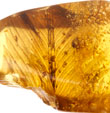 |
Possible 10 mm Dinosaur Feather in 100 Million Year Old Amber. Most amber is too young to contain dinosaur feathers, but Burmite is the name for 100 million year old amber found in the Hukawang Valley in northern Burma (Myanmar). These feathers could belong to an early bird or theropod dinosaur because what defines a dinosaur and an early bird is somewhat blurred. Both Coelerasaurs and Tyrannosaurs are known to have been feathered. This 8mm x 10mm clear partial feather is beautifully preserved in a 16 x 5mm polished cabochon of honey colored amber. The branching feather has excellent detail and is symmetric on both sides of the central rachis which means that it is not a flight feather but rather a body, tail or neck feather. Estimate Value $700 - UP
View details and enlarged photo
| Unsold |
Lot 695 |
 |
Pair of Armored 375 Million Year Old Fish Shields. Zyxhaspis sienmoradzkii was one of the primitive armored jawless fish that swam in the 375 million year old Eurypterid invested oceans near the present day Ukraine. Fish needed protective armor to survive the ferocious attacks of the top predator of their day, the sea scorpions which could reach lengths of over 10 feet. Zyxhaspis belonged to the genus Cephalsaspid and was a slow, bottom-feeding fish with eyes on the top of its skull and armor protection only on its head with the rest of its body and fins being unprotected. This excellent 8 x 6 inch plate contains two complete head shields 4 x 3 and 3 x 2.75 inches with their eye holes and some of the tiny patterns of light armor outlined in white calcite on the brown matrix. There is also part of a third disarticulated fish skull which is the normal condition found with complete head shields being rare. Estimate Value $700 - UP
View details and enlarged photo
| Unsold |
Lot 696 |
 |
9" Ancyloceras Aberramt Ammonite With Brown Iridescent Mother of Pearl. Large 9" long ammonite from Russia (Ancyloceras matheronianum) is over 100 million years old and has an unusual mostly uncoiled shape that started out with a tight curl and then began in uncoil as it grew larger. This large and spectacular ammonite is nearly complete with just the smallest inner curls missing with its original white mother-of-pearl shell coating fossilizing to an iridescent brown and tan with splashes of white still present. This museum quality and rare ammonite is nicely contrasted against its original black slate matrix. Estimate Value $700 - UP
View details and enlarged photo
| Unsold |
Lot 697 |
 |
Large Mancherochelys Turtle. Turtles are unique in the animal world having their entire torso embedded in a bony shell casing. There still is no consensus about their origins. Turtle fossils are usually just the carapace without the head and limbs. This 125 million year old 9 inch long Mancherochelys sp. fossil from Liaoning, China is the rare exception. It has an excellent 3-D 1.5 inch skull with a partial horn on its nose, carapace and parts of all four limbs and tail. This turtle has a complete shell and its light brown color is nicely contrasted against the lighter beige 10 x 7 inch stone matrix. Mancherochelys was a primitive Crytodira turtle with a horn on its head and could not withdraw its head and limbs inside like modern turtles. Estimate Value $600 - UP
View details and enlarged photo
| Unsold |
Lot 698 |
 |
Two Dinosaur Eggs -- Segnosaurus galbinensis. Segnosaurus ("slow lizard") galbinensis was carnivorous and lived in Mongolia during the late Cretaceous, 88-97 million years ago. These two eggs, one with about 90%, the other with about 40% of the original shell, rest on a nest that is 6 x 4". Weight is 4 lbs. 8.3 oz. Estimate Value $600 - UP
View details and enlarged photo
| Realized
$540 |
Lot 699 |
 |
Huge Foot Long 375 Million Year Old Crinoid Calyz. Crinoids, known as sea lilies, are relatives of starfish and like starfish have a five fold symmetry. This huge 10 inch long 6 inch wide Calyx (the flower part of the crinoid) is unusual in that it is in its living position having completely open branches which were used to filter-feed small organic particles and animals. The most minute details show in the individual arms as well as a remarkable star-like pattern at the base of the Calyx. There is also a two-inch section of the stem that would have been much longer when the crinoid was alive and attached to the ocean bottom. This impressive crinoid, Scyphocrinites, is a dark gray color against a 13 x 10 inch dark brown matrix and is 375 million years old, from Morocco. Estimate Value $500 - UP
View details and enlarged photo
| Realized
$360 |
Lot 700 |
 |
Mass Mortality Plate of Eight Complete and 12 Partial Trilobites. Some natural disaster occurred 480 million years ago to bury these 15 trilobites in their living position. What activity brought so many trilobites together can only be guessed at but some trilobite mating ritual is one possibility. These spectacular 3-D light brown Homotelus trilobites are from the Ordovician Carter County formation of Oklahoma. There are eight complete 1 ½ - 1 � inch trilobites and more than a dozen partial trilobites on a 9 ½ X 7 ½ inch stone matrix. All of these 100% original trilobites look very life-like as if they are crawling on the rolling ocean bottom. Estimate Value $500 - UP
View details and enlarged photo
| Realized
$461 |
Lot 701 |
 |
Huge Plate With Over 40 Starfish. This large 21 x 16 inch plate is 150 million years old from the famous fossil site of Solnhofen, Germany. This remarkable lithographic limestone slab contains more than 40 starfish 1½ inches in diameter of the Sinosura species. Sinosura was a brittlestar. Brittlestars are smaller and more delicate than the traditional starfish. Their five arms branched off of the central disk and could move independently of each other. Most of these starfish are complete and a medium brown color, which contrasts nicely against the light beige limestone matrix. Even though many beautiful fossils are found at Solnhofen, many tons of limestone have to be removed to find even a single fossil. It is truly remarkable to have so many fossil starfish on one plate. Estimate Value $475 - UP
View details and enlarged photo
| Realized
$461 |
Lot 702 |
 |
Rare Fossil of a 2" Great White Shark's Tooth With a Whale Vertebrae. Great White sharks are rare today and were probably even rarer in the past as their fossilized teeth are rarely encountered. This interesting fossil not only has a perfectly preserved 2 inch Great White Shark's tooth but also an 8 x 4 inch partial whale vertebrae that was probably the prey animal that caused the tooth to be dislodged from the shark's mouth. It is rare to find a predator prey event preserved in the fossil record. The remarkable fossils are preserved on a 11 x 8 inch sandstone matrix that is 2- 5 million years old from the Wingate Bay bonebed of the Pismo Formation in California. Estimate Value $450 - UP
View details and enlarged photo
| Unsold |
Lot 703 |
 |
Huge 17 Inch Long Diplomystus Green River Fish. Some of the best preserved fish in the fossil record are found in the 50-52 million year old Green River Wyoming fossil fresh water lake beds. This museum quality Diplomystus, an extinct member of the herring family, is a huge 17 inch long (close to the maximum size). The huge fish is complete with outstanding skin, fins and even some sharp little teeth in its distinctive upturned mouth, which enabled it to feed on small fish and creatures near the surface of the lake. The dark brown fish is nicely contrasted on the cream colored 28 x 18" sandstone matrix. This museum quality fish has been framed with a dark brown frame and is ready to be hung if so desired (hooks attached on back) although it can be displayed as is. Estimate Value $400 - UP
View details and enlarged photo
| Realized
$1,056 |
Lot 704 |
 |
Spinosaurus Foot Claw And Tooth. The enormous theropod dinosaur Spinosaurus with a huge sail on its back remains an enigma since no even remotely complete skeleton has been found and the only partial skeleton was destroyed in World War II. Spinosaurus is mostly known from its teeth, which are fairly common but usually broken and ugly. This lot contains a complete 2½" foot claw which was found in two pieces and professionally reattached. Also included is a complete 2 ¾ inch long tooth with excellent brown enamel, a partial ¾ inch root with just some of the usual crack filling This 80 million year old dinosaur claw and tooth were found in the Kem Kem Valley near Taouz, Morocco. Estimate Value $400 - UP
View details and enlarged photo
| Unsold |
Lot 705 |
 |
Rare Lizard Body and Tail in 100 Million Year Old Burmite Amber. Lizards are rarely trapped alive in amber because they are too big and strong to become trapped in the sticky sap. Complete lizards are extremely rare because most of the few partial lizards found have only their skin preserved. The reason for this is that if the lizard is dead before being covered with the sap, bacteria have already started to break down its tissue and this will continue even if the lizard is completely covered with the amber sap. This 15mm long lizard body and tail skin and some unusual small plants are preserved in a 40 x 20 mm 100 million year old Burmite amber nugget from Burma. Preserved in a 5½ x 4½" Riker mount with an enlarged photo of the lizard. Estimate Value $400 - UP
View details and enlarged photo
| Realized
$307 |
Lot 706 |
 |
Extinct Bipedal Insectivore Leptictis Complete Skull. Leptictis was a strange looking bipedal mammal that lived 35-40 million years ago in the White River Formation of South Dakota. Leptictis either hopped like a kangaroo or ran fast, feeding on insects, lizards and small mammals. It was related to hedgehogs, shrews and golden moles. This excellent 2.25 x 1 inch dark brown skull is still partially contained in its 3 x 2 inch light tan stone matrix as found. The skull has many sharp brown teeth and is perfectly centered in this stone matrix for display. Estimate Value $400 - UP
View details and enlarged photo
| Realized
$346 |
Lot 707 |
 |
Important Offering Of The Very First 525 Million Year Old Chordate Fossils. The 525 million year old fossils of Chengjiang are very important in being the earliest and best preserved of the early Cambrian fossils, being 15 million years older than the famous Burgess Shale of Canada. Many types of small weird animals are found at Chengjiang, but perhaps the most important are the small group of fossils representing the earliest chordates which are the earliest ancestors of the vertebrates of which we are members. Haikouella is a chordate known from about 300 specimens. This small swimming animal was only about one inch long but had a head, gills, brain, notochord, heart and circulatory system and perhaps small eyes. This remarkable grouping of more than 20 animals in a mortality grouping is also important as it shows that Haikouella was a social animal living together in groups either for protection or for hunting since they were predatory. Grouped together on a 5.5 x 3.5 inch slab, the gill slits which covered most of their body are very clear. Being soft bodied, any preservation is extraordinary. This important grouping is housed in a 12 x 8 inch Riker mount for display. Estimate Value $400 - UP
View details and enlarged photo
| Realized
$461 |
Lot 708 |
 |
Complete Polished Ammonite With Sutures. Ammonites were a squid-like animal that was covered with a shell that contained inside growth chambers. They became extinct 66 million years ago at the same time as dinosaurs. This complete large brown 7 inch diameter Placentioceras sp. ammonite has been polished revealing its beautiful suture patterns which are unique like fingerprints to each ammonite. In addition, this 75 million year old ammonite from the Pierre Shales of South Dakota preserves the fossilized red and green iridescent mother of pearl at the center of the ammonite. Estimate Value $400 - UP
View details and enlarged photo
| Realized
$252 |
Lot 709 |
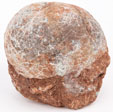 |
80 Million Year Old Duckbilled Dinosaur Eggs. This complete unhatched Hadrosaur (duckbilled) dinosaur egg is 70-80 million years old and measures 5½ inches tall and 6" inches wide, with 90% of the original shell. The exact species of dinosaur cannot be determined from just an egg, but this shape of egg has been determined to be from a duckbilled dinosaur from duckbilled dino bones found in the area of the nests of eggs. Such a Hadrosaur duckbilled dinosaur is Shantungosaurus, which has been found in the same area as the eggs and was one of the largest Hadrosaurs at more than 50 feet long. Duckbills herded together and nested in great numbers (100-200 large animals). Weight is 9 lbs. 8 oz. Estimate Value $400 - UP
View details and enlarged photo
| Realized
$360 |
Lot 710 |
 |
Primitive Whale Basilosaurus Partial Jaw and Tooth. Whales evolved from a four legged land predator (mesonychids) and the early whales still show characteristics of these bizarre wolf-like animals. Basilosaurus at 60 feet long was the largest predator in the ocean 40 -45 million years ago. Basilosaurus still had vestigial hind limbs and land predator type teeth. The completely natural 4 ½ inch partial jaw contains a large dark brown 2 x 1 ½" 6 cusped molar tooth with excellent enamel and one other partial tooth. This odd distinctive molar is double rooted with a high crown that was definitely used to tear flesh apart. This remarkable fossil was found in Wadi El Hitan Egypt which is known as Whale Valley. Basilosaurus is the state vertebrate fossil of Alabama and Mississippi. Estimate Value $350 - UP
View details and enlarged photo
| Unsold |
Lot 711 |
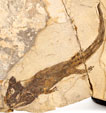 |
280 Million Year Old 6 Inch Long Amphibian With Skin. All fossils of the first amphibians are rare and found in only a few locations in the world. Amphibian fossils that still preserve their skin structure are even rarer. The best preserved amphibians come from a site closed to collecting for over 25 years in the Odernheim Pfatz in Germany. This 6 inch long amphibian, Microperpetron on a 11.5 x 6 inch matrix is nearly complete with an excellent 3-D skull with many little sharp black teeth, three legs with toes (front foot with three toes and two rear feet with four toes). There are skin impressions covering the entire body which show skin texture and patterns. The matrix was found in two pieces and expertly repaired with no damage to the fossil amphibian and is preserved in a 12 x 8 inch Riker Mount. Estimate Value $350 - UP
View details and enlarged photo
| Realized
$320 |
Lot 712 |
 |
Complete Aquatic 150 Million Year Old Reptile Sinohydrosaurus. Sinohydrosaurus lingyuanensisgen was a strange looking aquatic reptile with a very long neck that lived 150 million years ago in fresh water lakes in Liaoning Province, China. Sinohydrosaurus translates to Chinese water dragon. This 4.75 inch specimen on a 6.5 x 3.75 inch tuffaceous volcanic rock matrix is virtually complete (missing only some claws and a few digits in the feet) with all four legs, tiny rib bones and even smaller gastralia rib bones and most importantly an excellently detailed skull with the upper jaw filled with very small sharp teeth. Sinohydrosaurus may be an ancient relative of the fierce Komodo Dragon. This excellent quality specimen is preserved in a 8 x 6" Riker mount. Estimate Value $350 - UP
View details and enlarged photo
| Realized
$307 |
Lot 713 |
|
Withdrawn
| Unsold |
Lot 714 |
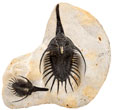 |
Pair of Shovel Nose Spiny Trilobite. One of the most spectacular spiny trilobites is the 375 million year old Psychopyge from Alnif, Morocco. Not only did it have short and long spines covering all of its body, but it also had a long shovel-like appendage in front of its head that was probably used to dig in the ocean bottom to find prey and possibly to hide from predators. This 7 x 4 inch light grey matrix contains two complete black Psychopyge trilobites. The larger specimen is 2.3 inches long and the small one 1.8 inches long. The larger specimen even has some of the lenses of its compound eye visible. While both trilobites are virtually complete there has been some restoration done to some of the delicate spines which is normal for this fossil trilobite. Estimate Value $300 - UP
View details and enlarged photo
| Realized
$552 |
Lot 715 |
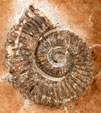 |
Museum Quality Heteromorphic Ammonite Aegocrioceras. This museum quality Heteromorphic ammonite Aegocrioceras is 125 million years old from Niedersachsen, Germany. The complete 3-D 3 x 2½" dark brown ammonite is well centered on a 6 x 5 inch light brown stone matrix. It is considered a heteromorphic ammonite as it is not tightly coiled like most ammonites, but just partially coiled and starting to uncoil. Estimate Value $300 - UP
View details and enlarged photo
| Unsold |
Lot 716 |
 |
T-Rex 2¼ Inch Shed Tooth. Virtually all T-Rex teeth found are shed teeth that broke off when the T-Rex was feeding on some other dinosaur. Usually these teeth are just fragments or are broken into many pieces, but this large 2¼ inch fragment is over 75 % of the total tooth. The tooth is exactly as it was found, with no restoration. It has one good side with the usual light cracks in the enamel that are always present. The back side has more enamel missing but the top serrations are very sharp. This 65 million year old tooth from Bowman County, North Dakota was found on a private ranch, along with the partial remains of a ceratopsian dinosaur that the T-Rex was eating when its tooth broke of. Displayed in a 8 x 10" Riker Mount. Estimate Value $300 - UP
View details and enlarged photo
| Realized
$230 |
Lot 717 |
 |
Complete 10 ½ Inch Cave Bear Jaw. Ursus spelaeus, the famous cave bear, was the largest bear that ever lived. It would have been nine to ten feet tall when standing on its hind legs. This complete lower jaw is between 20,000-150,000 years old and was found in caves in Romania. The jaw is 10½" long and 4¼" wide complete with all four large molars and a large 21/8" canine tooth. Three of the large molars are double molars with two teeth. The jaw is complete with a light brown color with no restoration and comes with a plastic stand for display. Estimate Value $250 - UP
View details and enlarged photo
| Realized
$179 |
Lot 718 |
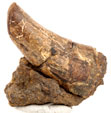 |
Juvenile 1 3/8 Inch T-Rex Tooth in Matrix. This complete T-Rex tooth is 1 3/8 inches long, thick for its size, has good serrations on the bottom, a little natural wear on its tip and some small cracks as normally found. All T-Rex teeth are shed teeth except the very few that are found with the dozen or so partial skeletons that have been found. This dark brown tooth has no restoration and is still in a small portion of its matrix. It was found in an ancient river or lake bed on a private ranch in the 65-67 million year old Hell Creek Formation of Powder River County, Montana. Estimate Value $250 - UP
View details and enlarged photo
| Realized
$180 |
Lot 719 |
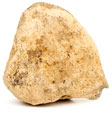 |
Large Ankylosaurus Body Spike, Scarce. Ankylosaurus is a well known armored dinosaur but its fossils are quite rare. This very large 3 ¼ x 3 ¼" body defensive spike of Ankylosaurus magniventris has no restoration and is complete except for a small one inch section on the back side. In life this spike would have been covered in keratin and would be much larger with a sharp point. While scutes are occasionally found, body spikes are very rare. This rare 66 million year old spike was found in the Hell Creek Formation of Wibaux County, Montana. Estimate Value $250 - UP
View details and enlarged photo
| Realized
$168 |
Lot 720 |
|
Withdrawn
| Unsold |
Lot 721 |
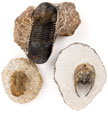 |
Collection of Three Different Shaped 375 Million Year Old Trilobites. Trilobites come in all shapes and sizes with over 10,000 different species known. Some of the best preserved tilobites come from the Atlas Mountains of Morocco. This collection of three trilobites are all 375-400 million years old. There is a 3 inch long Crotalocephalus looking like a strange bug with a bulbous head. Thysolopeltis is a 1.25 inch long scarce species defined by a wide fan-like pygidium (tail). And finally, a truly unusual-shaped 1.5 inch Harpes outstretched with a curled-up tail looking somewhat like a futuristic spaceship. All three trilobites are complete and original on limestone matrixes. Estimate Value $250 - UP
View details and enlarged photo
| Realized
$192 |
Lot 722 |
 |
Gigantic 11 Inch Long Trilobite. Acadoparadoxites was one of the largest and very earliest trilobite (over 500 million years old) that ever lived. This gigantic 11 x 10.5 inch trilobite was one of the largest predators of the mid Cambrian warm seas of Morocco. Found in the Atlas Mountain range of Morocco, this complete rust-orange trilobite nicely contrasts with the 17 x 17 inch original gray matrix. This spectacular trilobite comes from an old collection and is virtually complete with only minor restoration on the two spines on the cephalon (head) and a few tips of the genal spines. It is far superior to the average specimen encountered. Estimate Value $200 - UP
View details and enlarged photo
| Realized
$252 |